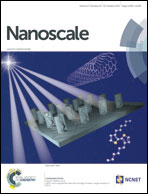Designer stabilizer for preparation of pristine graphene/polysiloxane films and networks†
Abstract
A conductive polymer film containing pristine graphene was prepared by designing a polysiloxane-based stabilizer for graphene. The stabilizer was prepared by grafting 1-ethynylpyrene to the backbone of a poly(dimethylsiloxane)-co-(methylhydrosiloxane) (PDMS-PHMS) random copolymer by Pt-catalyzed hydrosilylation with a SiH–ethynyl ratio of 1.0 : 1.3. The resulting copolymer was able to stabilize pristine graphene in chloroform solution via π–π interactions between the pyrene groups and graphene sheets. TEM and SEM images show a homogeneous distribution of the graphene in cast films deposited from chloroform. The conductivity of a graphene/PDMS film prepared from copolymer with a 1.7 vol.% graphene loading was measured as 220 S m−1 after the removal of unbound polymer by a simple separation technique. With a SiH–ethynyl ratio of 1.7 : 1.0, the copolymer self-crosslinked at 110 °C in the presence of adventitious moisture, providing a straightforward route to incorporate graphene into silicone elastomers. The crosslinking process (with and without added graphene) was characterized by FT-IR spectroscopy and by swelling and extraction of the obtained networks. Again, unbound polymer removal increases the conductivity of the composite.


 Please wait while we load your content...
Please wait while we load your content...